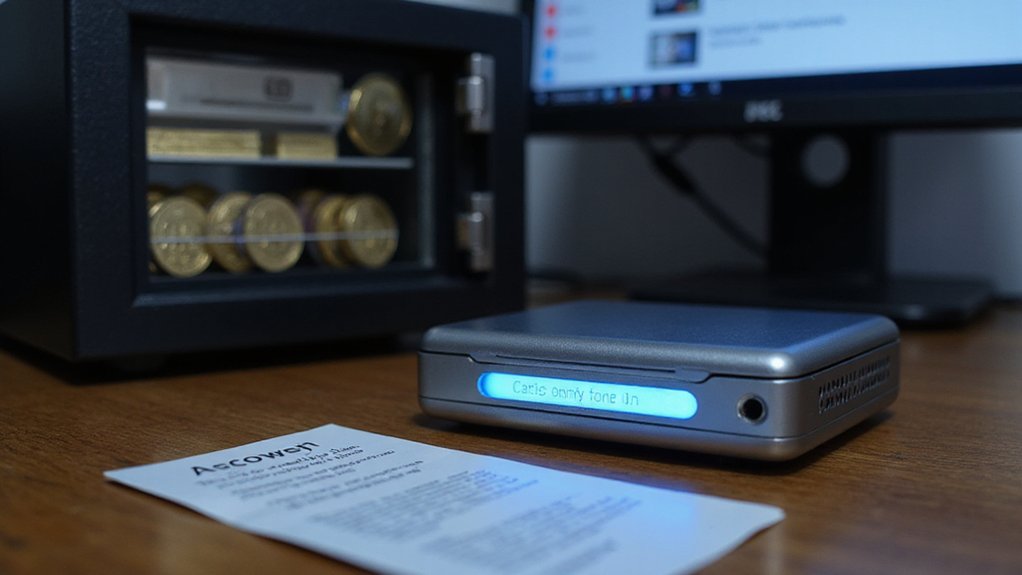TVL (Total Value Locked) represents the dollar value of all cryptocurrencies committed to smart contracts within a protocol’s ecosystem. Unlike traditional finance metrics susceptible to manipulation, TVL quantifies genuine capital commitment—whether through staking ETH, providing liquidity, or deploying assets in lending protocols. This metric rose to prominence during the 2020-2022 DeFi boom, reaching $179 billion at its peak. High TVL typically signals protocol robustness, though its calculation inherits cryptocurrency’s notorious price volatility. The nuances behind this deceptively simple metric reveal DeFi’s true gravitational force.

The financial pulse of the decentralized finance ecosystem, Total Value Locked (TVL) has emerged as the de facto metric for measuring DeFi’s collective economic gravity.
This figure—a dollar-denominated representation of all digital assets committed to smart contracts—offers a transparent window into market confidence that traditional finance metrics often obscure behind proprietary barriers.
TVL aggregates cryptocurrencies, stablecoins, and liquidity tokens that users have fundamentally removed from circulation to participate in various protocol mechanisms.
Unlike conventional financial indicators that tend to emphasize trading volume or market capitalization (metrics debatably susceptible to manipulation), TVL quantifies actual skin in the game.
TVL reveals genuine capital commitment while traditional metrics merely hint at market sentiment through potentially manipulated figures.
When users stake ETH into a yield-generating protocol or contribute USDT to a liquidity pool, they demonstrate conviction through capital commitment—a rather innovative concept in markets historically plagued by speculative excess.¹
The metric encompasses diverse participation methods: staking for network security, providing liquidity for decentralized exchanges, and deploying capital across lending protocols.
These liquidity pools function as automated market makers, allowing trades to execute without traditional order books while contributing significantly to overall TVL figures.
TVL calculation involves summing the market value of all locked assets at current prices, which introduces an inherent volatility unrelated to actual user behavior. TVL reached its historic peak of over $179 billion in December 2021 before experiencing significant fluctuations.
A protocol might see its TVL double overnight simply because its underlying tokens appreciated—not because new users arrived (an inconvenient reality that protocol developers rarely emphasize in their triumphant announcements).
Rising from obscurity during Ethereum’s early days to prominence during the 2020-2022 DeFi boom, TVL has become the preferred shorthand for ecosystem vitality.
Data aggregators like DeFiLlama track these figures in real-time, creating leaderboards that protocols chase with occasionally questionable incentive programs.
High TVL signals protocol robustness and typically correlates with increased security and network effects, while declining figures may signal user Exodus or diminishing confidence.
For investors exploring the labyrinthine DeFi landscape, TVL serves as a north star—imperfect yet indispensable—providing comparative insight into which protocols command market trust in an industry where such trust remains the scarcest commodity of all.
¹ Though one might reasonably question whether yield-chasing behavior truly represents long-term conviction.
Frequently Asked Questions
What Factors Can Cause TVL to Fluctuate?
TVL fluctuations stem from multiple interconnected factors: market price volatility of locked assets (particularly non-stablecoins), user deposit/withdrawal patterns driven by sentiment shifts, protocol developments (new features attracting capital or security concerns triggering Exodus), and broader market conditions.
Asset price movements often dominate these fluctuations—a 10% ETH price drop instantly reduces ETH-denominated TVL accordingly—while protocol-specific events like lucrative yield farming opportunities or (heaven forbid) exploits create localized TVL turbulence.
How Does TVL Compare to Market Capitalization?
While market capitalization represents a cryptocurrency’s theoretical value (price × circulating supply), TVL measures actual capital committed to protocols—making it a more concrete utilization metric.
Market cap encompasses speculative elements and broader market perception; TVL reflects genuine economic activity within DeFi ecosystems.
Savvy investors examine the TVL/market cap ratio to identify potentially undervalued assets where substantial locked value hasn’t yet translated to proportional market recognition—a disconnect that often signals overlooked fundamental strength.
Can TVL Predict Cryptocurrency Price Movements?
TVL serves as an imperfect crystal ball for price movements—more indicative than predictive.
While rising TVL often correlates with price appreciation (particularly in nascent protocols), this relationship proves frustratingly inconsistent.
The metric’s blind spots—ignoring token velocity, external market forces, and potential artificial inflation via yield farming—limit its prophetic powers.
Smart investors view TVL as one instrument in their analytical orchestra rather than the conductor determining when to enter or exit positions.
How Often Is TVL Data Typically Updated?
TVL data is typically updated in real-time or near real-time across major tracking platforms—a reflection of DeFi’s frenetic pace where millions can flow in or out within minutes.
Most aggregators refresh figures every few minutes, though update frequency ultimately depends on blockchain confirmation speeds, data provider infrastructure, and smart contract architectures.
Historical TVL snapshots are generally archived at daily or hourly intervals, allowing for trend analysis while the real-time feeds satisfy the market’s insatiable appetite for immediacy.
What Risks Come With Protocols Having Very High TVL?
Protocols with inflated TVL face multiple systemic vulnerabilities: they become honey pots for sophisticated attackers (the crypto equivalent of robbing Fort Knox rather than a corner store), while simultaneously creating precarious concentration risk.
Market volatility amplifies these concerns, as price fluctuations can trigger liquidity crises.
Governance typically suffers from centralization issues, with large stakeholders wielding disproportionate influence.
Perhaps most dangerously, high TVL creates a false sense of security—a deceptive halo effect that masks underlying vulnerabilities beneath impressive numbers.









